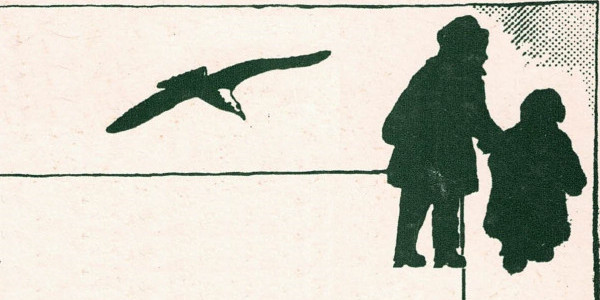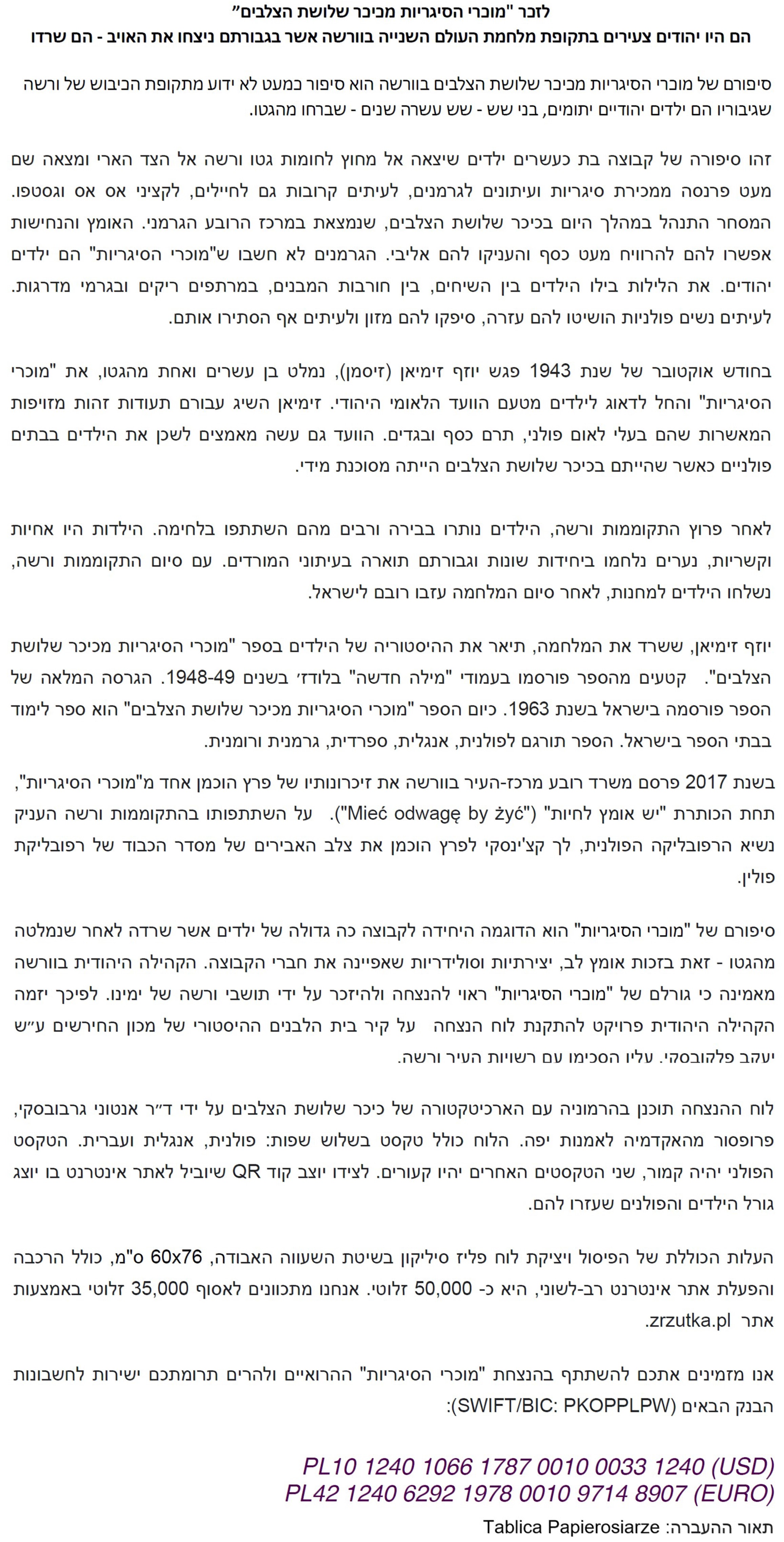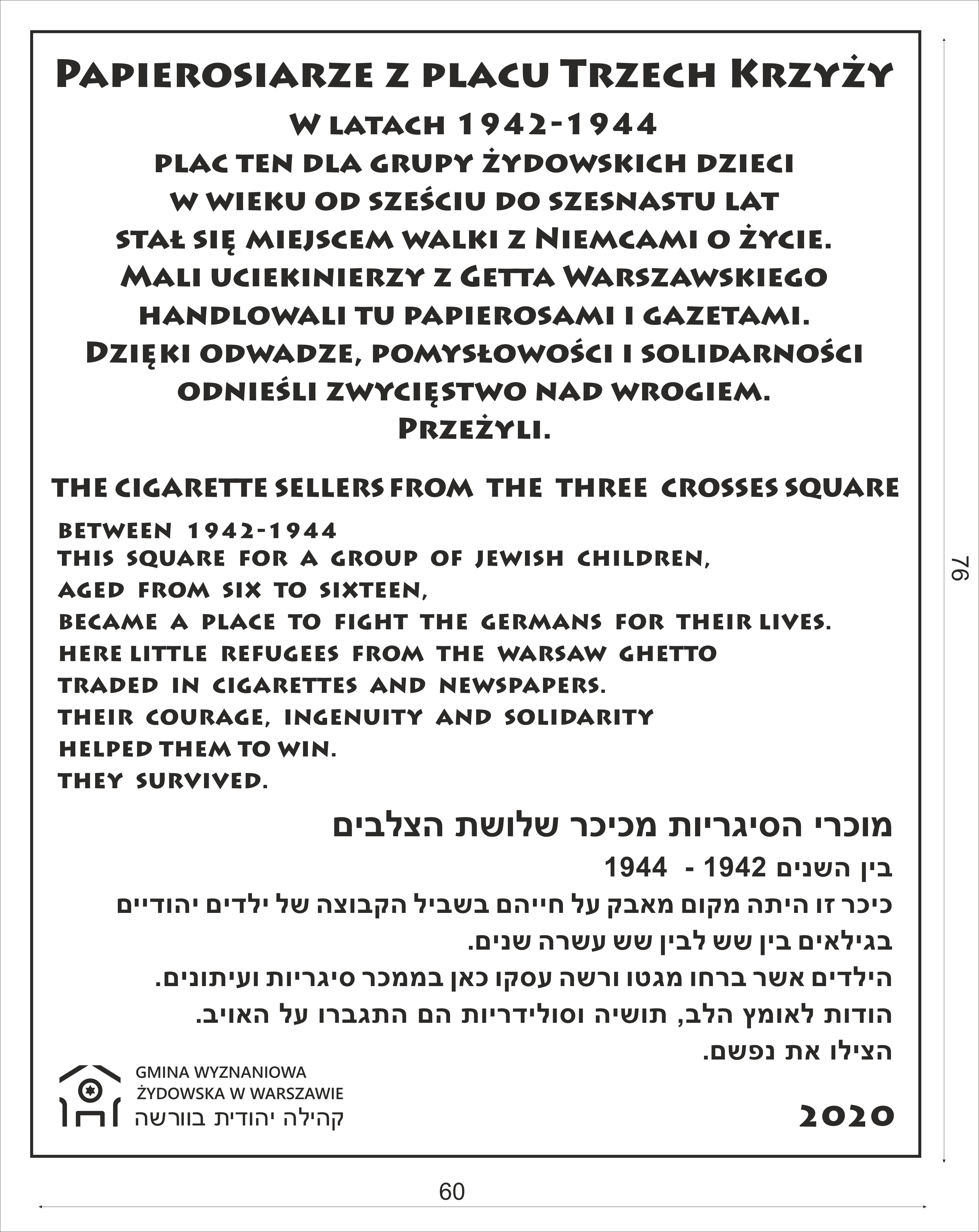Papierosiarze z Placu Trzech Krzyży - upamiętnienie
24/01/2021 | Na stronie od 24/01/2021

ZRZUTKA Jest organizowana zrzutka przez Gminę Wyznaniową Żydowską w Warszawie na tablicę przywracającą pamięć
Pamięć o „papierosiarzach” z placu Trzech Krzyży w Warszawie
Mali żydowscy bohaterowie czasów II wojny światowej, którzy zwyciężyli wroga – przeżyli
Dzieje „papierosiarzy” z placu Trzech Krzyży to niemal nieznana historia z życia okupowanej Warszawy, której bohaterami są żydowskie dzieci w wieku od sześciu do szesnastu lat – sieroty i uciekinierzy z getta.
Grupa około dwadzieściorga dzieci, które przedostały się poza mury getta warszawskiego na stronę aryjską, utrzymywała się ze sprzedaży papierosów i gazet Niemcom, często żołnierzom, oficerom SS oraz Gestapo. Dzieci handlowały w ciągu dnia na placu Trzech Krzyży, znajdującym się w samym centrum niemieckiej dzielnicy. Ich odwaga i determinacja dawały im zarobek i alibi. Niemcy nie przypuszczali, że „papierosiarze” są Żydami. Dzieci nocowały w krzakach, ruinach, pustych piwnicach i klatkach schodowych. Czasami pomagały im polskie kobiety, dożywiały je, niekiedy dawały schronienie.
W październiku 1943 roku na „papierosiarzy” natrafił uciekinier z getta dwudziestojednoletni Józef Ziemian (Zysman), który z ramienia Żydowskiego Komitetu Narodowego otoczył dzieci opieką. Ziemian załatwiał dzieciom fałszywe kenkarty potwierdzające polską narodowość, przekazywał pieniądze i odzież. Komitet podjął także starania o umieszczanie dzieci w polskich domach, gdyby przebywanie na pl. Trzech Krzyży okazało się zbyt niebezpieczne. Po wybuchu Powstania Warszawskiego dzieci pozostały w stolicy i wiele z nich wzięło udział w walkach. Dziewczęta były sanitariuszkami i łączniczkami, chłopcy walczyli w różnych oddziałach, a ich bohaterstwo było opisywane w gazetkach powstańczych. Po upadku Powstania Warszawskiego dzieci trafiły do obozów, a po zakończeniu wojny większość wyjechała do Izraela.
Józef Ziemian, który przeżył wojnę, opisał historię dzieci w książce „Papierosiarze z placu Trzech Krzyży”. Fragmenty były publikowane na łamach łódzkiego „Nowego Słowa” w latach 1948-49. Pełna wersja książki ukazała się w Izraelu w 1963 roku. „Papierosiarze z placu Trzech Krzyży” są obecnie lekturą szkolną w Izraelu. Książka została przetłumaczona na języki: polski, angielski, hiszpański, niemiecki i rumuński.
W 2017 roku nakładem Urzędu Dzielnicy Warszawa-Śródmieście zostały wydane wspomnienia jednego z „papierosiarzy” Peretza Hochmana pt. „Mieć odwagę, by żyć”. Peretz Hochman za udział w Powstaniu Warszawskim został odznaczony przez prezydenta RP Lecha Kaczyńskiego Krzyżem Kawalerskim Orderu Zasługi RP.
Losy „papierosiarzy” zasługują na zachowanie w pamięci mieszkańców Warszawy.
Historia „papierosiarzy” to jedyny przykład tak dużej grupy dzieci, które po ucieczce z getta przeżyły - dzięki swojej odwadze, pomysłowości i solidarności. Grupa Członków Gminy Wyznaniowej Żydowskiej w Warszawie uważa, że losy „papierosiarzy” zasługują na zachowanie w pamięci mieszkańców Warszawy. Dlatego zainicjowali projekt umieszczenia tablicy pamiątkowej na ścianie zabytkowej kamienicy Instytutu Głuchoniemych im. Jakuba Falkowskiego, na co wyraziły zgodę władze Warszawy. Tablicę, harmonizującą z architekturą placu Trzech Krzyży, zaprojektował profesor Akademii Sztuk Pięknych dr hab. Antoni Grabowski (www.antonigrabowski.com). Jest na niej tekst w trzech językach: polskim, angielskim i hebrajskim. Tekst polski będzie wypukły, pozostałe dwa teksty wklęsłe. Obok umieszczony zostanie kod QR, prowadzący do strony internetowej, na której przedstawione zostaną losy dzieci oraz upamiętnieni pomagający im Polacy.
Całkowity koszt wyrzeźbienia i odlewu tablicy z mosiądzu krzemowego metodą wosku traconego, o wymiarach 60 x 76 cm, wraz z montażem i uruchomieniem wielojęzycznej strony internetowej wyniesie około 50 tysięcy złotych. Poprzez zrzutka.pl zamierzamy zebrać 35 tysięcy złotych.
Chcielibyśmy zaprosić Państwa do wspólnego upamiętnienia bohaterskich „papierosiarzy” i wsparcia projektu środkami finansowymi.
Darowizny spoza Polski można wpłacać też bezpośrednio na poniższe konta (SWIFT/BIC: PKOPPLPW):
PL10 1240 1066 1787 0010 0033 1240 (USD)
PL42 1240 6292 1978 0010 9714 8907 (EURO)
tytułem przelewu: "Tablica Papierosiarze"
Commemoration of Cigarette Sellers of Three Crosses Square (Polish: Plac Trzech Krzyży) in Warsaw.
The little Jewish heroes of World War II who defeated the enemy – they survived.
The history of Cigarette Sellers of Three Crosses Square is a little-known story of the occupied Warsaw: that of a small group of about 20 Jewish children aged six to sixteen - orphans and refugees from the Warsaw ghetto, who managed to escape from the Warsaw ghetto and were lucky to get alive to the Aryan side.
They made a miserable living there selling cigarettes and newspapers to the Germans, often to soldiers, SS and Gestapo officers. The children worked during the day at Three Crosses Square, located in the very center of the German district. Their courage and determination gave them a little money and an alibi - the German occupiers did not know that the Cigarette Sellers were Jews. The children lived and slept rough: in bushes, ruins, empty cellars and staircases, in a nearby hospital - hungry, cold and very brave. Sometimes they were helped by Polish women, who gave them food and shelter.
In October 1943, Józef Ziemian (real name Zysman), at that time 21 and also a fugitive from the ghetto, contacted the Cigarette Sellers, and took care of them on behalf of the Jewish National Committee. Ziemian provided the children with false identity cards confirming their Polish nationality, gave them money and clothes. The committee also made attempts to place the children in Polish homes, should their presence in and around Three Crosses Square be too dangerous. After the outbreak of the Warsaw Uprising in 1944, the children remained in Warsaw and many of them took part in the fighting. Girls were nurses and messengers, boys fought in various units, and their heroism was described in insurgent newspapers. Following the fall of the Warsaw Uprising, the children were sent to German internment camps, and after the war, most of them left for Israel.
Józef Ziemian, who survived the war, described the history of the children in the book Cigarette Sellers of Three Crosses Square. Excerpts from this book were published in a Lodz newspaper Nowy Dzień in 1948-49. The full version of the book was published in Hebrew in Israel in 1963. The book Cigarette Sellers of Three Crosses Square is currently a school reading in Israel. The book has been translated into the following languages: Polish, English, Spanish, German and Romanian.
In 2017 the memoirs of one of the Cigarette Sellers Mr. Peretz Hochman entitled To Have the Courage to Live were published by the Warsaw Council. Peretz Hochman for his heroism during the Warsaw Uprising was awarded by the President of the Republic of Poland Mr. Lech Kaczyński with the Knight's Cross of the Order of Merit of the Republic of Poland.
The story of Cigarette Sellers is the only example of such a large group of Jewish children who survived after escaping from the ghetto - thanks to their courage, creativity and solidarity.
A group of members of the Jewish Religious Community in Warsaw firmly believe that the fate of Cigarette Sellers needs to be remembered by people living in Warsaw and visiting Warsaw, and for this reason they initiated the project of placing a commemorative plaque on a wall of a historic building housing the Institute for Deaf Children founded by Jakub Falkowski in the XIX century. The project has the approval of the Warsaw authorities. The plaque, in harmony with the architecture of Three Crosses Square, was designed by the professor of the Academy of Fine Arts, Mr. Antoni Grabowski (www.antonigrabowski.com). The text is in three languages: Polish, English and Hebrew. Polish text will be convex, the other two texts will be concave. Next to it a QR code will be displayed, linking to a website where the fate of the children will be explained and the Poles who helped them will be commemorated.
The total cost amounts to 50.000 PLN. We intend to collect 35.000 PLN by zrzutka.pl.
The cost includes: carving and casting of the brass plaque made of siliziumtombak using the traditional lost-wax process, dimensions 60 cm x 76 cm, together with the installation and the launch of a multilingual website.
We are inviting you to help to commemorate the heroic Cigarette Sellers and support the project financialy.
Donations from outside Poland can be also made directly to the following accounts (SWIFT/BIC: PKOPPLPW):
PL10 1240 1066 1787 0010 0033 1240 (USD)
PL42 1240 6292 1978 0010 9714 8907 (EURO)
Payment description: "Tablica Papierosiarze"

